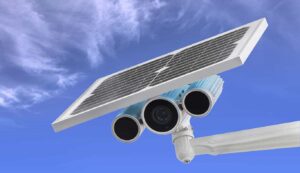| Contact us if you are a camera manufacturer / supplier or a property manager / construction company and you have questions about remote power for IP enabled cameras |

What is an IP Enabled Camera?
An IP enabled camera, also known as a network camera or internet protocol camera, is a type of digital video camera that receives and sends video data over an IP network. Unlike analog cameras that require a direct connection to a recording device, IP cameras can transmit footage over the internet or local network, making them accessible from anywhere with an internet connection.
Key Features of IP Enabled Cameras:
- Network Connectivity: IP cameras connect to a network via Ethernet cable or Wi-Fi, allowing for remote access and monitoring.
- Digital Video: These cameras capture video in a digital format, which can be easily stored, transmitted, and analyzed.
- Power over Ethernet (PoE): Many IP cameras support PoE, which allows them to receive both power and data through a single Ethernet cable, simplifying installation.
- Advanced Features: IP cameras often include features like motion detection, video analytics, two-way audio, and night vision.
Applications of IP Enabled Cameras:
IP enabled cameras are used in a wide range of applications, including:
- Home Security: Monitoring homes and deterring burglars.
- Business Surveillance: Protecting assets, monitoring employees, and enhancing security.
- Traffic Monitoring: Observing traffic flow and managing traffic signals.
- Remote Monitoring: Keeping an eye on elderly relatives, pets, or vacation homes.
The Rise of Off-Grid Solar Power for IP Enabled Cameras
Traditionally, IP enabled cameras rely on grid power for operation. However, there’s a growing trend towards using off-grid solar power systems to provide a reliable and sustainable energy source for these cameras, especially in remote locations where grid access is limited or unavailable.
Benefits of Off-Grid Solar Power for IP Enabled Cameras:
- Cost Savings: Solar power eliminates or reduces ongoing electricity bills, providing long-term cost savings. Moreover, if your camera is in a remote area, it can cost over $50,000 per mile to connect it to an electric grid so it is much more economically viable to install an off-grid solar powered system.
- Environmental Friendliness: Solar energy is a clean and renewable resource, reducing carbon emissions and environmental impact.
- Reliability: Off-grid solar systems with battery backup ensure continuous operation even during power outages.
- Remote Accessibility: Solar power enables the deployment of IP cameras in remote areas where grid connectivity is challenging.
- Increased Flexibility: Solar-powered cameras can be installed in locations where running power cables is difficult or impractical.
Components of an Off-Grid Solar Power System for IP Enabled Cameras:
- Solar Panels (Modules): These capture sunlight and convert it into electricity.
- Solar Charge Controller: This regulates the flow of electricity from the solar panels to the batteries, preventing overcharging and damage.
- Solar Batteries: These store the electricity generated by the solar panels for use when sunlight is unavailable, such as at night or during cloudy weather.
- Backup Power Source (Optional): A generator or fuel cell can provide additional power during extended periods of low sunlight.
- Network Connectivity: A cellular modem or satellite internet connection may be required for remote access to the camera footage.
Challenges in Choosing the Right Components:
- Solar Charge Controller: Selecting the appropriate type (PWM or MPPT) and size of the charge controller is crucial for optimal system performance and battery longevity. MPPT controllers are generally more efficient, especially in low-light conditions.
- Solar Module: Factors like panel efficiency, power output, and durability should be considered based on the camera’s power consumption and location’s climate. Monocrystalline panels are generally more efficient but also more expensive than polycrystalline panels.
- Solar Battery: Battery capacity, type (lead-acid, lithium-ion), and cycle life are important considerations to ensure sufficient backup power. Lithium-ion batteries offer longer lifespan and better performance but come at a higher cost.
Challenges in Installing and Maintaining Off-Grid Systems:
- Site Assessment: Evaluating solar irradiance, shading, and environmental factors is essential for optimal system placement and performance.
- Installation Expertise: Proper installation of solar panels, wiring, and components requires technical knowledge and experience.
- Remote Maintenance: Accessing remote sites for maintenance or repairs can be challenging and costly.
- Environmental Factors: Extreme weather conditions, wildlife, and vandalism can pose risks to the off-grid system.
- Network Connectivity: Ensuring reliable network connectivity in remote areas can be difficult and may require specialized equipment.
Conclusion
Off-grid solar power is becoming an increasingly popular solution for powering IP enabled cameras, especially in remote and challenging environments. While there are challenges in selecting the right components, installing, and maintaining these systems, the benefits of cost savings, reliability, environmental sustainability, and increased flexibility make it a compelling option for powering IP cameras in the modern age. Careful planning, expert installation, and regular maintenance are crucial for maximizing the performance and lifespan of off-grid solar-powered IP camera systems.
